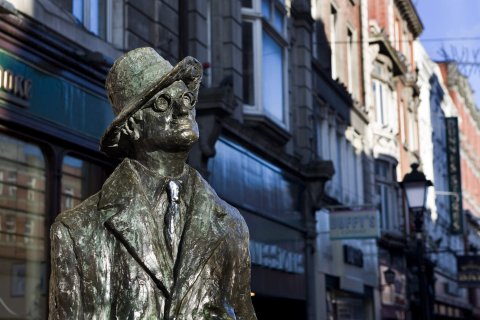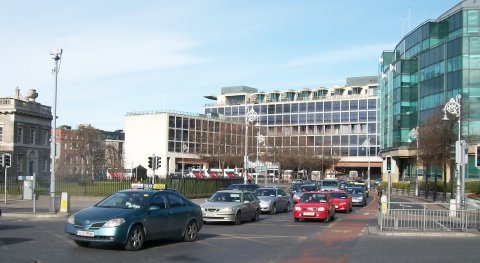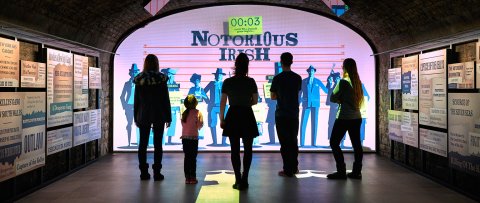码头区之旅

都柏林城市画廊(原名休·莱恩画廊)是一家免费开放的公共画廊。开放时间为周二至周四上午9:45至下午6:00,周五上午9:45至下午5:00,周六上午10:00至下午5:00,周日上午11:00至下午5:00。都柏林作家博物馆于1991年首次开放,展出了都柏林一些最优秀的文学作品。博物馆开放时间为周一至周五:上午 9:45 至下午 4:45,周日上午 11:00 至下午 4:30。马路对面的纪念花园是为了纪念那些为爱尔兰自由事业献出生命的人们,由 Dáithi Hanly 设计,中间有一座由 Oisín Kelly 创作的描绘利尔儿童的雕塑,伊丽莎白二世女王在 2011 年对都柏林进行国事访问期间在花园里敬献了花圈。帕内尔广场附近是亨利埃塔街 14 号,这是一个令人惊叹的景点,描绘了都柏林公寓楼的生活。

在这里,您可以看到丹尼尔·奥康奈尔的雕像。他于1829年为爱尔兰争取到了天主教解放,并成功推翻了剥夺爱尔兰天主教徒诸多权利的刑法。这座雕像由青铜人物和花岗岩底座构成。它高40英尺,底座上有四个天使,分别代表着丹尼尔·奥康奈尔最容易联想到的美德:爱国、勇气、雄辩和忠诚。据说,每个天使也分别代表爱尔兰、伦斯特、芒斯特、阿尔斯特和康诺特四个省。

都柏林中央汽车站和爱尔兰巴士公司的总部,提供许多区域和城际路线。这里也有 LUAS 红线和 Airlink Express 的连接。它由迈克尔·斯科特于 1945 年至 1953 年间设计,被认为是国际现代风格的典范。该建筑于 1955 年荣获爱尔兰皇家建筑师学会三年一度的金奖(爱尔兰建筑最高奖项)。从 Busáras 拐角处不远处就是都柏林海关大楼和詹姆斯·康诺利纪念碑。这个站点也在康诺利火车站旁边 - 如果您想乘坐都柏林达特河一日游,前往都柏林北侧的霍斯和马拉海德等沿海村庄,或南部的 Seapoint、布雷和敦劳费尔,这里是完美的起点。

从这一站下车,参观都柏林最好的新景点之一——Epic——爱尔兰移民博物馆。——强烈推荐!您还可以在这一站参观饥荒纪念馆以及都柏林最著名的地标建筑之一海关大楼。海关大楼最初于 1791 年开放,目的是向进入都柏林港的人员征收关税。该建筑由著名的英国建筑师詹姆斯·甘登(也是四法庭的设计者)设计,无疑有着丰富多彩的历史,在爱尔兰独立战争中发挥了作用。珍妮·约翰斯顿饥荒船也位于此站旁边。

欣赏都柏林超现代的一面,包括由世界著名的爱尔兰裔美国建筑师凯文·罗奇设计的会议中心和由世界著名桥梁设计师圣地亚哥·卡拉特拉瓦设计的塞缪尔·贝克特桥(卡拉特拉瓦在都柏林利菲河上设计的两座桥梁之一)——它们都近在咫尺。这些 21 世纪建筑的美丽典范分别于 2010 年和 2009 年开放,可欣赏到美丽的风景。

漫步汉诺威码头,欣赏由世界著名德国建筑师丹尼尔·里伯斯金(纽约世贸中心新自由塔的设计者)设计的现代杰作——博德盖斯能源剧院(Bord Gáis Energy Theatre),以及另一位世界著名设计师玛莎·施瓦茨(Martha Schwartz)设计的令人叹为观止的景观。既然来了,何不去看看演出呢?从这里步行几分钟就到了风车巷录音棚(Windmill Lane Recording Studios)。

参观爱尔兰水道游客中心,尝试一下独木舟或皮划艇,或者去著名的皮尔斯街图书馆。皮尔斯街以前称为新不伦瑞克街,以着名革命家和 1916 年复活节起义领袖帕特里克·皮尔斯(和他的兄弟威利·皮尔斯)的名字命名,他们出生并成长于 27 号街,至今仍可见到。拐角处就是都柏林最著名的街道之一韦斯特兰街,其历史可以追溯到 18 世纪后期,是皮尔斯火车站的所在地。乘坐都柏林区域快速交通系统 (DART),沿着都柏林的北海岸和南海岸行驶,可以欣赏到美妙的景色。火车北行至都柏林郡的马拉海德或霍斯,南行至威克洛郡的布雷或格雷斯通。韦斯特兰街也是奥斯卡王尔德的出生地。

在三一城市酒店 (Trinity City Hotel) 对面下车,沿着皮尔斯街 (Pearse Street) 步行即可到达科学馆。科学馆于 2008 年在都柏林圣三一学院 (Trinity College Dublin) 开业,举办各种讲座和展览,适合各年龄段的游客。免费入场。开放时间为:周一上午 8:00 至下午 5:00,周二至周五中午 12:00 至晚上 8:00,周六/周日中午 12:00 至下午 6:00。

码头区之旅的倒数第二站是都柏林巴士总部,地址是上奥康奈尔街59号。马路对面是英国建筑师伊恩·里奇设计的尖顶。它是都柏林最高的地标建筑,高达120米(390英尺)。奥康奈尔街是都柏林市的主干道,也是1916年复活节起义的主要战场。从这里下车,即可参加经典之旅。